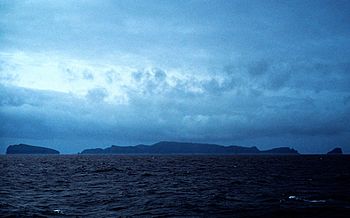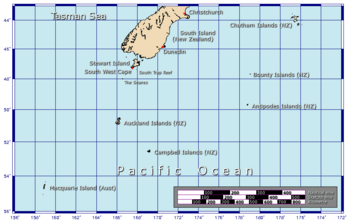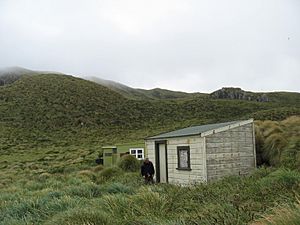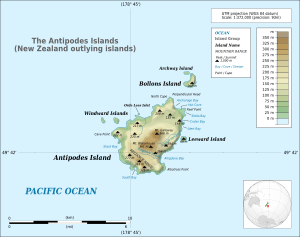Antipodes Islands facts for kids

The Antipodes Islands seen from the north
|
|

Position relative to New Zealand and other outlying islands
|
|
| Geography | |
|---|---|
| Location | 860 kilometres (464 nmi) southeast of Stewart Island |
| Coordinates | 49°40′S 178°46′E / 49.667°S 178.767°E |
| Archipelago | Antipodes Islands |
| Major islands | Antipodes, Bollons |
| Area | 21 km2 (8.1 sq mi) |
| Highest elevation | 366 m (1,201 ft) |
| Highest point | Mount Galloway |
| Administration | |
| Demographics | |
| Population | 0 (2006) |
| Additional information | |
| Nature reserve | |
The Antipodes Islands are a group of small, uninhabited volcanic islands. They are located far to the south of New Zealand in a very cold part of the ocean. These islands are part of New Zealand's territory.
The whole group of islands covers about 21 square kilometers (8 square miles). They are about 860 kilometers (534 miles) southeast of Stewart Island/Rakiura. They are also about 730 kilometers (454 miles) northeast of Campbell Island.
The main island is called Antipodes Island. It is about 20 square kilometers (7.7 square miles) in size. To its north is Bollons Island, and there are many smaller islets and rocky stacks.
These islands are a special nature reserve. This means that the general public is not allowed to visit them. They are also part of a World Heritage Site recognized by UNESCO. This protects their unique natural environment.
Contents
What Does "Antipodes" Mean?
The name "Antipodes" comes from an old Greek word. It means "with feet opposite (ours)." Imagine someone standing on the exact opposite side of the Earth from you. That's what "antipodes" refers to!
The islands were first called the Penantipodes. This meant "next to the antipodes." They are very close to being the exact opposite point on Earth from London, England. Over time, the name was shortened to just Antipodes. The actual opposite point of the islands is near Cherbourg, France.
Exploring the Geography of the Antipodes Islands
The Antipodes Islands are volcanic. They are located about 860 kilometers (534 miles) southeast of Stewart Island. The group includes the main Antipodes Island and many smaller islands and rocks.
Bollons Island is the second largest island. It is about 2 square kilometers (0.77 square miles) in size. Other islands include Archway Island, Leeward Island, and the Windward Islands. There is also tiny Orde Lees Islet. Many small islets and rocky stacks surround the main island.
The islands are very steep. Most of their coasts have cliffs and rocky reefs. The highest point is Mount Galloway. It is 366 meters (1,201 feet) tall. This mountain is part of the most recently active volcano in the group. Mount Waterhouse is also very tall, over 360 meters (1,181 feet).
Several small streams flow from the mountains. The largest is the Dougall Stream. It flows northeast to the east coast. The Ringdove Stream flows east to Ringdove Bay.
A Look at the History of the Islands
Early Discoveries and Visitors
There is no clear proof that people visited these islands before Europeans found them. Some stories mention a piece of ancient Polynesian pottery found in 1886. However, the Museum of New Zealand Te Papa Tongarewa has not found this pottery in its collection.
Sealing and Its Impact
Captain Henry Waterhouse discovered the islands in 1800. He was sailing on HMS Reliance. He reported that there were many seals on the islands. Soon after, a "sealing boom" began between 1805 and 1807.
American ships like the Favorite and Independence arrived in 1805. Their crews killed about 60,000 seals in one year. At one point, 80 men were on the islands. There was even a fight between American and British sealing groups. One ship carried over 80,000 seal skins. This was one of the largest shipments ever from this region. The skins were sold for a lot of money. After 1807, sealing stopped because most of the seals had been killed.
Famous Shipwrecks and Castaways
Many years later, a ship called the Spirit of the Dawn crashed near the main island in 1893. Eleven of the sixteen crew members survived. They were stranded on the island for almost three months. They ate raw muttonbirds, mussels, and roots. After 87 days, they used a flag made from their sail to get the attention of a government ship.

There was a special hut on the other side of the island. This hut was filled with supplies for castaways. But the survivors were too weak to reach it because the island was so mountainous.
The crew of a French ship, the President Felix Faure, used this hut in 1908. Their ship was wrecked, and they were stranded for 60 days. They were eventually rescued by HMS Pegasus.
The last shipwreck at the Antipodes Islands was the yacht Totorore in 1999. Sadly, two people, Gerry Clark and Roger Sale, lost their lives.
Nuclear Testing Ideas
In 1955, the British Government looked for a remote place to test new nuclear weapons. The Antipodes Islands were suggested as a possible site. However, this idea was not pursued.
Amazing Plants and Animals
The Antipodes Islands have unique plants, including very large herbs called megaherbs. The islands are also home to many different bird species.
Some birds found here are found nowhere else in the world. These include the Antipodes snipe and the Antipodes parakeet. You can also find several types of albatrosses, petrels, and penguins. Half of the world's population of the erect-crested penguin lives here!
The original population of fur seals on the islands is thought to be gone or in great danger. Some scientists believe that "Upland Seals" found here and on Macquarie Island were a special type of fur seal.
Why Are These Islands Important for Birds?
The Antipodes Islands are known as an Important Bird Area (IBA). This means they are very important for many seabirds to breed and raise their young.
Some of the seabirds that breed here include:
- Southern rockhopper and erect-crested penguins
- Antipodean, black-browed, light-mantled, and white-capped albatrosses
- Northern giant, grey, and white-chinned petrels
Protecting the Islands
Like many other islands, the Antipodes Islands faced problems from introduced animals. Mice were brought to the islands and caused harm to the native wildlife.
In 2012, a project called "Million Dollar Mouse" was started. Its goal was to raise money to get rid of the mice. This was part of New Zealand's "Predator Free 2050" plan. In 2016, the Department of Conservation dropped bait from helicopters. They also used trained dogs to find any remaining mice. This effort successfully removed an estimated 200,000 mice from Antipodes Island.
The islands are surrounded by a large marine reserve. It is called the Moutere Mahue / Antipodes Island Marine Reserve. It covers about 2,173 square kilometers (839 square miles) of ocean. This helps protect the marine life around the islands.
See also
 In Spanish: Islas Antípodas para niños
In Spanish: Islas Antípodas para niños




